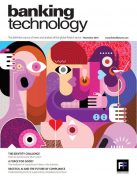Banking Technology November 2019 issue out now
The identity challenge
The latest edition of our flagship magazine – Banking Technology – is out now, packed with news, analysis and insights, case studies, research and expert commentary.
A note from our editor, Sharon Kimathi:
Artificial intelligence, machine learning and data have been strong themes at various conferences this year – like many years before. However, people are now questioning the ethics, concepts and types data used behind these tools to determine its results.
Rutger Van Faassen, VP of consumer lending at Informa Financial Intelligence argues that in order for AI, ML and deep learning to be successful, one needs to guide ML to understand the right concept using the right data. Many financial institutions find themselves in a situation where they have a lot of data about their customers, but don’t know how to apply ML or AI to the data, or the initial results are disappointing.
Our very own reporter, Ruby Hinchliffe, explores how disappointing results can emerge from the wrong type of data being used for such a result, as she reveals her discomfort at AI being used to predict “financial risks” such as the probability of someone getting a divorce by observing a person’s banking patterns.
This rather sinister revelation led her to the conclusion that if events such as divorce – something which plagues nearly one in two (42%) marriages across the UK – ever become a determining factor for a mortgage, then people by and large will be far more ready to hold the lending industry’s biases to account.
Both Hinchliffe and Nadia Sood, CEO at CreditEnable, find that the industry’s human biases of old have now shifted to algorithmic biases, meaning black and ethnic minority borrowers are charged higher interest rates costing them up to half a billion dollars more every year than white borrowers with similar credit scores in the US.
But lending is not the only sector with an issue as the financial services industry is also plagued by misusing AI. Ian Holmes, global lead for enterprise fraud solutions at SAS notes that an alarmingly small number of financial institutions are leveraging the appropriate solutions to identity fraud. Aite research shows that only 10% of organisations are actively using ML analytics to orchestrate authentication. While 50% are in the process of implementing these solutions or have them on their road maps, a worrying 40% are not.
Holmes adds that banks need to take steps to prove the value of AI and advanced analytics and demonstrate how these solutions can bring new levels of flexibility and convenience to customers. This principle should not only be applied to identity fraud, but AI biases as well.
The November 2019 edition of Banking Technology features:
Through a Gen Z lens
Til a mortgage do us part
Thought leadership
AI: could it be a force for good?
Analysis
How is AI augmenting compliance practices?
Editor’s choice
How digital transformation can blossom
Insight
How can banks know who’s who?
Focus
The common data format that benefits everyone
Spotlight
Ensuring AI works with legacy solutions
I’m just saying…
Beyond personalisation
Food for thought
Tall tales of big ambitions and small parcels
Ask the expert
Practical, free advice on how to grow your business.
And not to forget the Regulars of course:
News – the good, the bad and the ugly.
Appointments – the movers and the shakers.
Industry events – mark your calendars!
Click here to read the Banking Technology November 2019 edition











































